Grain & seed farm confined spaces
Confined spaces on grain and seed farms can be dangerous. Employers and workers must understand the hazards and know how to work with them before entering the confined space.
The hazards
Below, you'll find general information to help you assess the hazards of confined spaces on grain and seed farms. Please note: there may be confined spaces on your farm not listed here.
Augers and conveyors transport solid material either from a container to a vehicle or from one location to another. The enclosure containing the auger or conveyor is considered a confined space.
Depending on the grain being transported, toxic gases may build up in conveyor system. Grain can emit fumigants and dust. Bacteria and mould can also grow in accumulated dust with sufficient moisture.
Augers and conveyors that are not enclosed contain moving parts, such as rollers and belts, that could pose a risk to workers.
| Hazards | Hazardous work |
|
|
 |
 |
| Conveyor in a tunnel | Conveyor in a tunnel |
If there is not enough ventilation, crawl spaces or cellars may contain a toxic or low-oxygen atmosphere. The combination of metal and moisture can deplete oxygen because oxygen is used as metal rusts. Other toxic gases may also accumulate, depending on the use of the building above the crawl space or material being stored in the crawl space.
| Hazards | Hazardous work |
|
|
 |
 |
 |
 |
| Exterior crawl space entrance |
Interior crawl space entrance |
Exterior crawl space entrance |
Crawl space |
Some operations store grain or seed on-site in bins for partial processing before shipping. This involves drying and cleaning, and sometimes fumigation.
Grain bins have flat or tapered bases. Some tapered bases may be below-ground. Bins also have side access doors and one or more access hatches on the roof.
Depending on the amount of grain in the bin, entry may be possible through:
- The top hatch only
- A combination of the top and side hatches
- Partial opening of the side door
- Complete opening of the side door
When entry is necessary from the top or through partial opening of the full-sized side door, the bin is considered a confined space. Bins with sloped floors might always be considered confined spaces because they are difficult to access.
Normally, storing grain bins do not produce toxic gases. However, workers entering bins must take into account previous use of pesticides or fumigants and possibly mould. If the grain's moisture content is too high, the grain may ferment; toxic gases can build up and replace oxygen in the air.
Grain may not flow smoothly and can form bridges or shoulders that are an engulfment hazard. Workers may also be struck by fragments of bridges and hang-ups.
| Hazards | Hazardous work |
|
|
 |
 |
 |
 |
| Grain bins | Grain bin | Clean-out auger | Clean-out auger |
Grain dryers include mobile and fixed equipment that provide a flow of dry air through the grain to remove moisture. Grain dryers use natural gas and propane as fuel sources. Direct-fired units inject combustion gases into the flow of heated air. As a result, the dryer and grain bin will contain combustion gases. After turning off the heater, purging is necessary to remove remaining combustion gases from the atmosphere.
To prevent fires in the grain or grain dust during operation, equipment manufacturers recommend maintaining a small difference in temperature between the heated air and ambient air.
Grain dryers may also contain mechanical equipment, such as conveyors and augers.
| Hazards | Hazardous work |
|
|
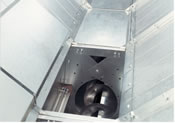
Grain-drying equipment
Mobile equipment used on grain farms may include:
- Tank wagons (e.g., pesticides and fertilizers)
- Seed applicators
- Harvesting equipment
- Transportation equipment (e.g., field trailers or highway trailers)
These types of equipment may contain augers and moving floors.
Tanks may contain toxic gases from fermenting material, such as liquid manure or aerosols from pesticides. These gases and vapours are toxic and can quickly cause death when inhaled at high concentrations. Some cleaning chemicals can also produce very toxic gases, even in residual quantities. Also, low oxygen conditions may occur if the tank has been empty for some time. Interior surfaces in these structures are also likely very slippery, which could lead to entrapment.
On some units, the power take-off of the tractor powers mechanical equipment on the unit and the tractor's hydraulic system powers the unit's hydraulic system. On other units, the tractor's engine powers mechanical movement and the hydraulic system. It's possible for energy to remain in circuits after the tractor has been shut down and linkages and hoses have been disconnected.
| Hazards | Hazardous work |
|
|
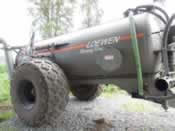
Tank wagon
A pump station (also known as a lift station) is a below-ground chamber that collects drainage from surface and subsurface sources. Pumps move the liquid to a higher level. Higher levels may include an above-ground storage tank, drainage structure, or sewer.
Pump stations on grain farms handle drainage from the grain-processing area. This water contains nutrients and organic debris from plant parts. Pump stations may also handle relatively clean water collected from roofs and other sources, as well as surface drainage for transfer to ditches.
Pumps can agitate the sludge and release trapped toxic gases. Agitation thins the fluid and causes bubbles and foam, releasing gas into the air. High concentrations of these gases can cause death in a few seconds.
| Hazards | Hazardous work |
|
|
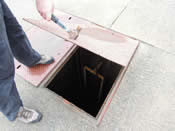 |
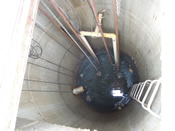 |
| Lift station hatchway | Lift station |
Grain farms in rural areas are not part of municipal sanitary collection systems. These operations must have standalone sewage treatment facilities, including collection and processing chambers.
In these confined spaces, wastewater treatment can result in low-oxygen conditions and produce toxic gases. Inhaling these toxic gases at high concentrations can quickly cause death.
| Hazards | Hazardous work |
|
|

Septic tank hatchways
Sumps are below-ground chambers that collect drainage from surface and subsurface sources. When the trap in the outflow pipe overflows, collected water is transferred to another location through the outflow pipe. Sumps act as separation chambers before discharging to stormwater drainage. Stormwater manholes serve the same function but may not include the separation capability.
On grain farms, sumps can accumulate organic matter in runoff from various sources. Sludge can trap gases from anaerobic digestion. Agitation thins the sludge, releasing these gases. Fermentation gases are toxic and can rapidly cause death when inhaled at high concentrations.
| Hazards | Hazardous work |
|
|
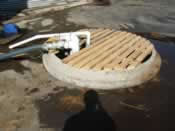 |
 |
| Drainage sump | Stormwater manhole |
A well pit is the chamber at the top of a wellhead. If the chamber is located under the floor of a building it is considered a confined space.
The well pit provides access to the well and pumping equipment. It also prevents freeze-up in the pressure tank and piping.
Normally, hazardous gases won't be present in a well, as long as there is vey little (or no) organic material in the water. However, oxygen depletion can occur when metal rusts. This is most likely when the well pit is closed for a long time and condensation forms on metal surfaces.
| Hazards | Hazardous work |
|
|
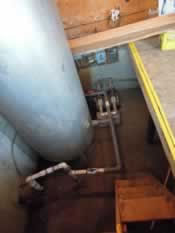 |
 |
| Well pits |
Highlights
- New risk advisory on the dangers of fire and explosion in asphalt mix plants Published on: August 15, 2023
- New online tool helps workers and employers manage risk by delivering a custom list of health and safety resources Published on: December 05, 2022
- New slide show highlights the importance of protecting workers from the hazards of confined spaces in agriculture Published on: August 29, 2022

